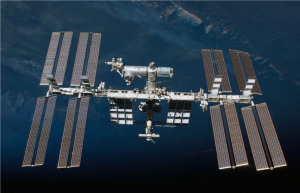By: Richard (Rick) Davis, Hannah Duke, Kallia Smith, Bob Collom
During a recent presentation to student interns at NASA, we received many questions. Although we were not able to answer all of them during the talk, we wanted to address as many as we could. Here are our answers to the first half of those questions. We welcome ideas and feedback. Great ideas can come from anywhere, and we want to encourage everyone to share their expertise and knowledge.
How do you join the mailing list?
You can join the mailing list by emailing NASA-Mars-Exploration-Zones@mail.nasa.gov.
Mr. Collom or Mr. Davis, do either of you have LinkedIn or another way to stay in touch?
For more information about the Human Landing Sites Study, go to our website. We also have information about internships. You can also follow Rick on Twitter @RedPlanetRick. Let us know if you have any other questions!
I think Bob mentioned working in spaceflight policy. What is the average day working in spaceflight policy like?
Spaceflight policy for getting humans to Mars is a relatively new area and projects are constantly evolving and growing, so a day in Mars spaceflight policy is anything but average. One moment you’re drafting a white paper that summarizes key topics for decision-makers, and the next moment, you’re organizing a meeting with space agencies from around the world. Other day-to-day tasks may include advocating for money to be spent on a specific project or searching for outreach opportunities that will reach young audiences. Spaceflight policy facilitates collaboration with subject matter experts across many areas who want to contribute to Mars exploration but are very busy, so you must be flexible, patient, and pleasantly tenacious. The ability to strategically plan, concisely communicate, curiously ask questions, and learn as you go are all important in this field. If you are willing to work hard, be bold in your pursuits, and understand that ‘we’ is a thousand times more powerful than ‘I’, Mars spaceflight policy can be a really cool way to contribute to the ever-dynamic world of Mars exploration.
Is that the spacesuit from The Martian (movie) on the first slide?
It’s an artist’s rendering of a potential suit for a future mission, but the visual design was inspired by The Martian. The suit from The Martian was based on discussions between NASA and the team behind The Martian about design considerations for a spacesuit.
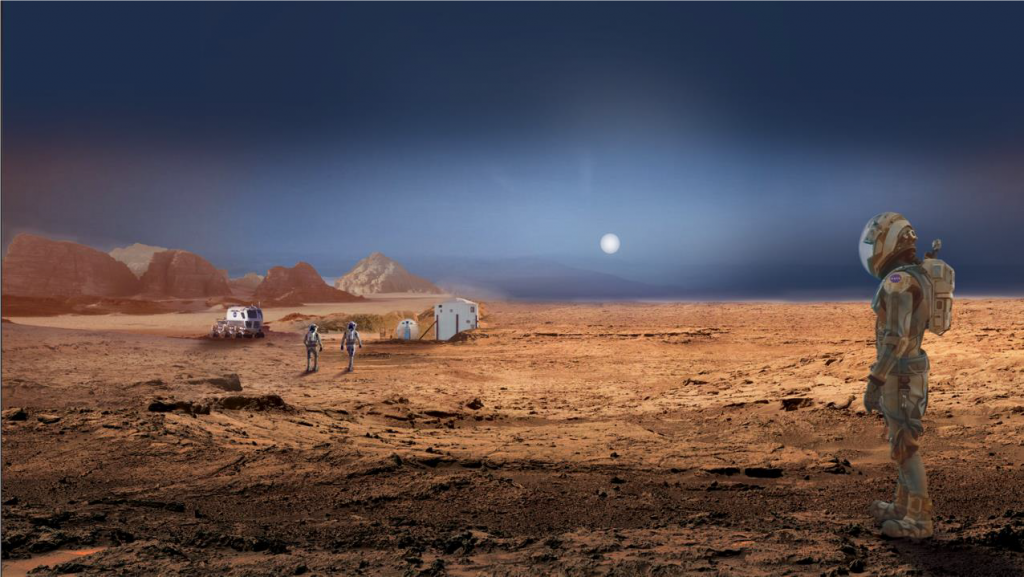
So we never have had a spacecraft go to Mars AND return to Earth?
That is correct. All orbiters and landers so far have remained at Mars. However, our newest rover, Perseverance (launching this summer), will collect samples from the surface of Mars with the plan of returning them to Earth through the Mars Sample Return Campaign. This campaign will be a key step in getting humans to Mars as it will be the first-ever round trip to Mars and back, including the first launch from the surface of Mars.
Has the time it takes to send rovers to Mars decreased over the years
Based on the most efficient orbital trajectory, the time to travel to Mars is between 6-9 months, and all the rovers sent so far have had an average of an eight-month-long trip. Windows of time for launching to Mars are based on the locations of Earth and Mars relative to each other as they go about their orbits. The launch window for the most efficient trajectory opens every 26 months.
What are your plans to reduce the cost of these missions so that astronauts and billionaires aren’t the only people on Mars?
Increased innovation and partnerships are key for reducing the cost of missions. When innovation is aimed at getting us to Mars more efficiently, it can lead to new methods and techniques that save a lot of money. Innovation is occurring across many areas such as entry, descent, and landing systems, small nuclear reactor designs, and supersonic retropropulsion techniques. Partnerships are also key for lowering costs and enabling innovation. For example, NASA’s Commercial Crew & Cargo Program has invested significantly in the private sector to develop more efficient and cost-effective space transportation methods. The Artemis program (the first step towards maintaining human presence in deep space) is leveraging similar partnerships with American companies who will deliver payloads to the moon through the Commercial Lunar Payload Service (CLPS). We anticipate that similar partnerships will help cultivate a more cost-effective exploration of Mars.
Is Mars covered under the Outer Space Treaty? As more countries travel to Mars, how do you enforce that everyone follows the same rules to avoid international conflict on Mars?
Mars is covered under the Outer Space Treaty, which states that space is free for all countries to explore for the benefit of humanity, is currently the guiding principle for government in space. However, the treaty does not implement specific laws or a governing body to enforce them. As more countries move into space and as more people begin to live in space, we don’t yet know how the treaty will evolve to cover the specifics of everyday life on the moon or Mars.
How do you think private companies such as SpaceX will impact our trip to Mars?
Going to Mars is a collective human effort, so we are going to need a lot of institutions, both private and international, to work together. This will bring in new ideas and allow for more efficient production and cost sharing.
What technologies of the lunar Artemis missions do you see translating over for future Martian missions?
Lunar missions can teach us many lessons in preparation for Mars. The principal mission components, such as habitat, rover, and power system designs, will likely be similar in both environments. For example, the Mars Ascent Vehicle could be modeled off the vehicle launching from the moon. In addition, lunar suits will need to be lightweight (gravity on the moon is 1/6 that of Earth’s, while gravity on Mars is 1/3), easy to maintain, protect from dust, and have high mobility which are all things Mars suits will need. However, there are also critical differences between operating on the moon and operating on Mars. For example, Mars has an atmosphere (albeit very thin), whereas the moon does not, so entry, descent, and landing (EDL) systems used for a lunar landing will not necessarily apply to Mars. Since the moon has no atmosphere and can have up to two-week nights, equipment will stay very cold for long periods of time. In contrast, Mars has a more Earth-like day (averaging 24 hours and 39.5 minutes), so equipment won’t have to face such long durations of extremely low temperatures.
How long are people going to spend “living” on Mars?
Missions to Mars will include a 6-9 month trip there, 500 days in the Martian system (either in orbit or on the surface), and a 6-9 month journey back. Looking at the history of exploration, such as McMurdo Station in Antarctica, the ISS (see pictures below), and Mars rovers, we generally take a step-by-step approach as we build up to more capability. For example, initial rover missions to Mars were very small (see picture below), but now we can send rovers weighing about a metric ton to the surface. If we assume that this approach applies for human missions to Mars, it suggests that initial surface missions will likely be short stays, with the majority of the astronauts’ time spent in orbit. As we gain more experience on the surface of our second planet, we would expect the time on the surface to greatly increase.

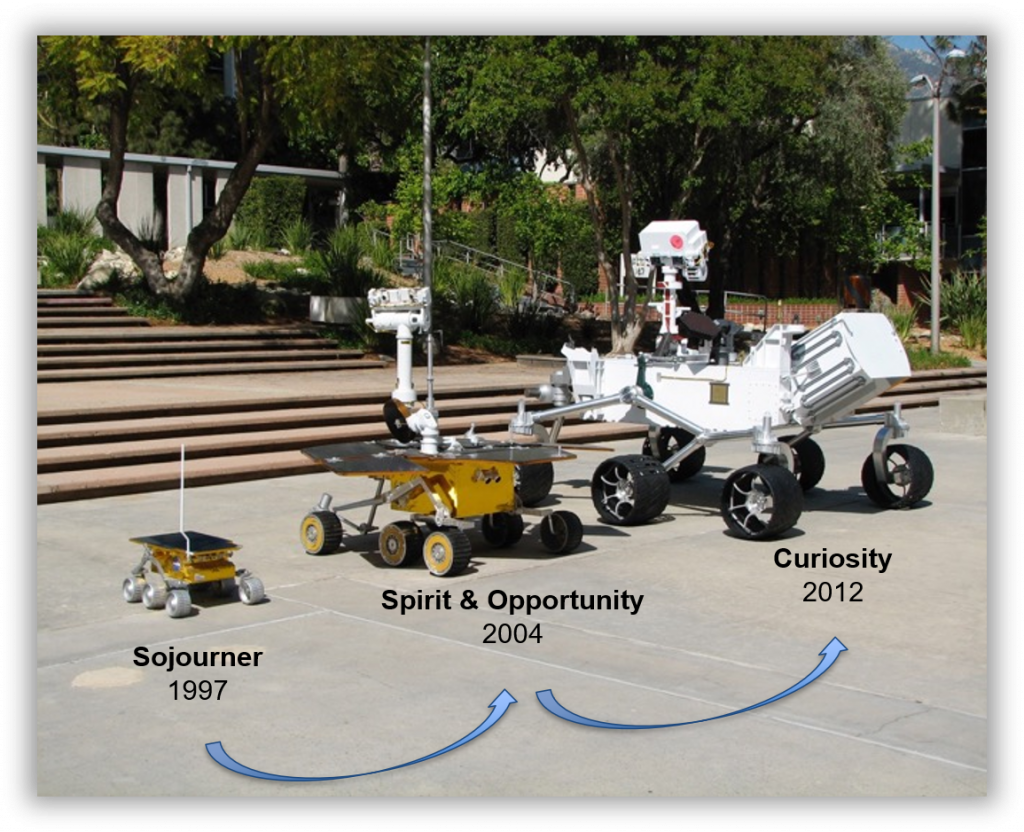
When thinking about the people who will go to Mars, do you think a crew will be made up of people from strictly STEM fields, or that there will be a need to think more expansively about who should go, especially with a much longer timeline?
Initially, a Mars crew will include highly technical people. We anticipate that some of the disciplines needed will probably include, doctors, engineers, pilots, and other scientists such as astrobiologists. We may even need artificial intelligence experts to operate the computers. We also expect astronauts to cross-train when needed. For example, a pilot might train as a backup doctor in case the doctor gets sick. In addition, we fully anticipate that these missions will be international missions, so the crew must work well in a multi-cultural, remote, high-stress environment. As we continue to develop a more sustained presence on the surface of Mars, the occupations needed will likely expand, reflecting more of the diversity of occupations found on Earth.
What are the objectives/tasks of the astronauts once they land on Mars? Has that part of the plan been discussed yet?
As we stand on the surface of another planet for the first time, there will be many exciting and fascinating science objectives waiting to be explored by Mars astronauts. For example, there is a chance that life could exist on Mars, and explorers will have the opportunity to conduct astrobiology studies with more expertise and depth than ever before, possibly uncovering the first evidence of past or present life outside Earth. In addition to astrobiology studies, there will be many other high priority science objectives likely including in-depth studies of the geology, climate, atmosphere, and human research, to name a few. NASA has had several studies to help determine which activities would benefit most from having a human present (rather than robots or rovers) on the surface of our second planet. Humans will bring more creativity, adaptivity, and responsiveness to the Martian environment, enabling a more advanced process of discovery.
In addition to conducting major science activities, we expect that the astronauts will check out and assemble equipment and modules that landed prior to the crew’s arrival. Some of this assembly will aim to create a sustained presence on the Red Planet. This human activation and assembly approach worked very well on the ISS, and we expect that it will work well on Mars too.
Will astronauts on Mars be growing and eating their own food or primarily relying on supplies? In regard to renewable agricultural systems on Mars, what are some ideas that have been proposed?
For initial missions, we will likely send pre-packaged food with the crew. However, there are challenges associated with preserving taste and nutritional value in food that has been stored for long periods. If we can figure out how to grow food efficiently on Mars, we can fix the issues concerning taste and nutritional value while also reducing the total mass transported from Earth. Agriculture on Earth requires large amounts of dirt and water, which would be very heavy to carry into space, so astronauts would need to utilize efficient agricultural systems and local resources to grow their food. Since the regolith on Mars does not contain organic material, one option is to use hydroponics, where a plant grows in a nutrient-rich solution that doesn’t require dirt. It might also be possible to grow plants using minerals found in the Martian regolith, but toxins such as perchlorates would have to be removed. Despite the challenges, implementing an efficient agricultural system on Mars would reduce the mass and cost of missions while likely increasing morale for the astronauts.
Would astronauts have separate suits for space travel as well as Mars surface or is it one suit that handles both conditions?
Mars astronauts will need a different suit for surface exploration than the spacesuits they will use in zero-gravity to perform spacewalks or exterior repairs to the Mars Transit Vehicle. In general, surface suits will have to be lighter, easier to maintain, and will have to withstand elements like dust better than current spacesuits. ISS spacesuits weigh about 275 pounds on Earth, but since they are worn in zero-gravity, the weight is less important. (The mass of the suit, however, is still an essential consideration due to inertia. Once you start moving, it’s a lot more challenging to slow down or stop since there’s no gravity or friction.) However, in Martian gravity (about 38% of Earth’s), astronauts will feel the weight of their suits, so Mars surface suits will have to be much lighter while also maximizing mobility. In addition to being lighter, Mars surface suits will also have to be easier to maintain than current spacesuits. It won’t be ideal to have suits that require a lot of maintenance or prep before excursion like the ones on the ISS. Another challenge for surface suits is the need to keep dust out. On the moon, the regolith has not been weathered, so during Apollo missions, it acted like shards of glass, slicing astronauts’ suits when they moved their arms. On Mars, we expect the regolith to be more weathered than the moon, but this is still a concern for suit integrity. Also, if there is any life on Mars, it could be transported through the dust, which is another reason to have dust-proof surface suits.
Do we need to bring water from Earth? If so, how do you bring so much water to Mars?
Water is heavy, which presents a challenge when bringing it from Earth. However, the presence of water feedstocks (sources) on Mars offers many opportunities to extract and use water for various demands. Water on Mars comes in several forms, such as subsurface ice (major ice deposits just below the surface of Mars) and hydrated minerals (water molecules contained within minerals), both of which could be harvested for use by humans on Mars. Bringing some water will be necessary for the trip from Earth to Mars. However, we want to maximize the amount of water we can get from Mars by carefully choosing a landing site conducive to in-situ resource utilization (ISRU). For initial missions, the most extensive water demand will likely be propellant for the Mars Ascent Vehicle (MAV).
What do you think about settling on the moons of Mars rather than the planet, to avoid the gravity well?
Mars’s moons, Phobos and Deimos, are very low gravity bodies, to the extent that landing on them is more like docking in space. This will probably make them well-suited for short visits, but less so for extended settlement, since it’s more difficult for humans to live and work in microgravity, as on Phobos or Deimos, than in partial gravity, as on Mars. Initial missions to Mars could very likely be orbital missions as we work our way up to landing missions, and some of these orbital missions could include sorties to land on Phobos and Deimos.

Could you explain how we are going to have breathable air on Mars?
95% of the Martian atmosphere is carbon dioxide, which can be broken down into oxygen and carbon monoxide. The oxygen can then be used to produce breathable air. The Mars Oxygen In-Situ Resource Utilization Experiment(MOXIE), an instrument on the Perseverance rover, will test the technology necessary for this process.
Are we still considering something like the dome-like structures tested at HI-SEAS?
Initial missions to Mars will likely use smaller pre-built modules, because smaller modules are easier to transport and land on Mars. Domes may also require local construction, instead of being prefabricated on Earth, which would be very challenging on the Martian surface. Future, longer-term missions may use a dome-like design because they provide a larger volume for the crew to live in. If these domes are clear, they could even simulate the feeling of being “outside” without a Mars suit on.
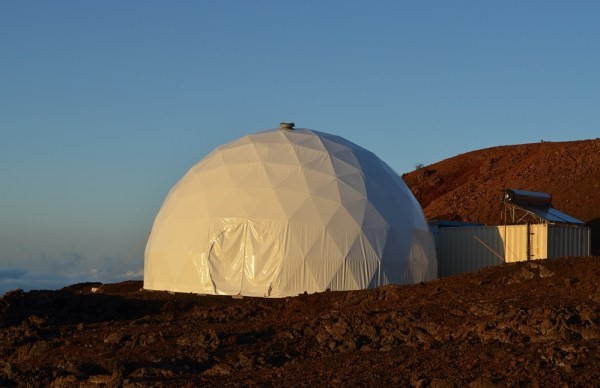
Do you think that the protection afforded by underground structures to dust storms are worth not having windows?
We do not generally anticipate that dust storms would be a reason to design habitats without windows. Due to the low density of the air, the force exerted by wind would be low, and therefore would not affect the integrity of the windows.
Reducing the crew’s total radiation exposure may be a reason to consider underground structures. In that case, a combination of aboveground and underground structures may be ideal. Astronauts could sleep underground to reduce their total radiation exposure, while living areas aboveground could allow astronauts to monitor/operate activities outside. Aboveground structures also promote the psychological benefits of seeing the surrounding environment and sunlight. For an idea of what these structures on Mars might look like, check out this fascinating TED Talk by Bjarke Ingels.
Having such windows has been incredibly helpful on the ISS (pictured below) because it provides astronauts a way to oversee/monitor spacewalks and robotic arm activities as well as conduct Earth observations.
How do you test radiation protection ideas on Earth? Is there a test facility? How far from Earth do you need to go for a representative environment?
NASA has several facilities that test whether electronics and other instruments on a spacecraft can withstand deep space radiation (you can read more about one of these types of centers here). A lot of the protection measures we hope to implement will integrate radiation-shielding materials into spacecraft and surface structure (habs, labs, etc.) designs. Since we have flown dosimeters out into deep space, we have a good idea of how much radiation humans would experience from both solar radiation and galactic cosmic radiation (GCR). A representative environment of deep space radiation occurs outside the Earth’s magnetosphere (pictured below), which traps energetic charged atomic particles in areas called the Van Allen Belts, protecting Earth’s atmosphere from receiving high amounts of radiation.
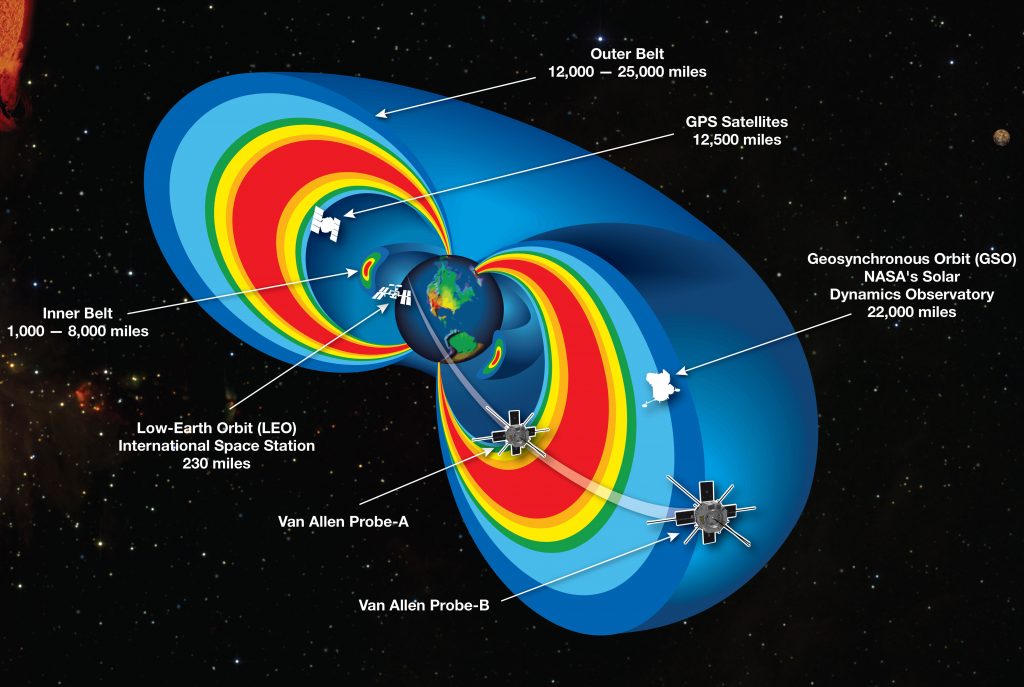
How effective is electric propulsion on the surface of Mars?
We won’t use electric propulsion on the surface of Mars. Rovers will use either electricity stored in fuel cells or batteries or generate their own electricity through solar panels or radioisotope thermal generators (RTGs). Curiosity and Perseverance both make use of RTGs, which uses the decay of plutonium to create heat and electricity. You can read more about the use of this power supply on Perseverance here. On the cold surface of Mars, power will be critical, and the most likely sources of electricity will be solar panels, RTGs (possibly on the rover), and small nuclear fission reactors. Rovers will need to be able to store this energy which can be done using fuel cells or batteries.
Are there any other plans to produce energy on Mars, that are sustainable, other than solar panels?
Solar power alone will probably not meet the full energy needs of a human mission to Mars. Dust storms on Mars could block out sunlight, making the atmosphere opaque enough that there is not enough light reaching the solar panels to generate power. A human crew may also land at a mid-latitude location on Mars, where days are much shorter than nights in winter, again providing less sunlight. To deal with these challenges, NASA is currently working to develop compact nuclear reactors that will not be dependent on solar energy. Unfortunately, other sustainable energy options such as wind and geothermal energy are not viable options for renewable energy on Mars. The winds are less powerful due to the extremely low density of the Martian atmosphere, and we have not yet found evidence of widespread geothermal activity.
Is the reason to keep the lander and Mars Ascent Vehicle as separate vehicles to leverage ISRU for fueling the Mars Ascent Vehicle (rather than carrying all the necessary fuel)?
To make Mars missions more affordable, we will need to learn to use local resources to reduce the overall mass transported from Earth. One of the biggest ways to do this would be to use Mars resources to create the fuel and oxidizer necessary for the Mars Ascent Vehicle (MAV). We will take advantage of the CO2 rich atmosphere by extracting the oxygen for use as our oxidizer. For the first missions, we plan to take methane for the fuel with us, but over time, we can utilize water (H2O) sources on Mars to produce the hydrogen needed for methane (CH4) with the carbon coming from the atmosphere. Using ISRU to create fuel and oxidizer for the MAV would drastically reduce the amount of mass transported from Earth. This, in turn, greatly reduces the overall cost of Mars missions.
How much thrust or ISP will you need to get off the surface of Mars?
The amount of thrust needed to get off the surface of Mars will depend on the mass of the Mars Ascent Vehicle (MAV). A lot of work is being done to minimize the mass of the MAV. Thrust and specific impulse (Isp) are separate concepts, but both are important components to launching the MAV. Thrust is the force generated by the propulsion system. Specific impulse (Isp) defines the efficiency of the propulsion system and depends on the type of propellant used. To reduce the cost of Mars missions, we are looking at using local resources on Mars such as methane and oxygen for the MAV propellants. Both can be produced locally and stored easily. Since local resources will drive our choice of propellants, they will also drive what the specific impulse to get off the surface will be.
I’ve seen that SpaceX is developing their Raptor engine that runs off methane instead of the typical liquid oxygen (LOX) mixture; is NASA developing a similar style engine to use on Mars? I believe they chose methane in hopes of being able to develop more fuel in-situ.
Yes, NASA is currently planning to develop a methane engine. Most Mars mission architectures generally assume that a methane engine will be used because methane (CH4) can be made locally by combining carbon from the atmosphere and hydrogen from water. Oxygen, which must be combined with the fuel (in this case, methane) for the engine to ignite, can also be made locally using carbon dioxide in the atmosphere of Mars. In addition, methane is easy to store for long periods of time.
Is artificial gravity not currently viable for the MTV? What are the largest constraints?
Artificial gravity is a possibility for future missions, but initial human missions will probably not require it. As seen with astronauts on the ISS, consistent exercise helps counteract the bone and muscle loss that occurs from living in zero-gravity. It also appears that the bone and muscle loss levels out over time spent in space. However, we should be mindful that ISS missions are usually about 180 days whereas Mars missions will be about 1100 days, so we would be extrapolating our knowledge. We believe that we can manage these effects of zero-gravity through exercise for longer missions, but we need more data from astronauts who have spent more time in space to be sure. If we find we cannot manage zero-gravity effects with exercise for Mars missions, we may then consider other solutions such as artificial gravity for the Mars Transfer Vehicle.
We could generate artificial gravity by rotating a section of the spacecraft, simulating the feel of gravity through centrifugal force. However, there are many challenges that come with this. If the rotating arm is too short, astronauts may experience dizziness anytime they turn their heads away from the plane of motion. In contrast, making the arm longer would pose a significant engineering challenge since building and launching a more massive spacecraft would be more difficult and expensive.
When planning our first missions to Mars, we must carefully consider which technologies are mission-essential. As we have found in previous programs (such as the International Space Station), we can anticipate some risks, but there are other risks that we will only learn of as we start to plan, train, and execute missions in that program. We need to keep the Mars Transfer Vehicle as simple as safely possible so that we can get to Mars sooner rather than later and learn about these other risks. These risks, particularly on an 1100-day mission, could also be a danger to the crew, so we need to understand them so that we can manage them along with the risks we are currently aware of.
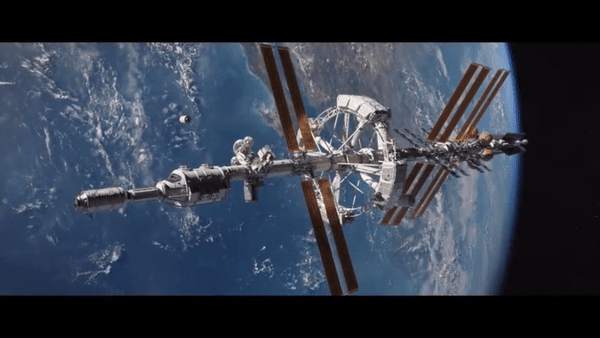
How do you think ion engines will fit into longer distance space travel? Although they offer slower accelerations, they do offer longer “burn” times and can eventually reach the same velocities as liquid chemical engines?
Ion engines, or electric propulsion in general, will likely be a key part of enabling travel to Mars because this type of engine reduces the amount of propellant needed to reach Mars. However, they are slower to accelerate. For transporting cargo, travel time doesn’t matter as much, making electric propulsion a slow but cost-effective option, much like we use slow-moving barges to transport cargo on Earth. For human crews, the best solution may be a hybrid that includes a high-thrust chemical engine and efficient electric propulsion.
How far has exercise science been developed for extended time on Mars?
The exercise regimen for astronauts on Mars will likely resemble the regimen for astronauts on the ISS. Since Mars has one-third the gravity of Earth, the effects on the body will likely be less extreme than ISS astronauts experience in zero-gravity. Regardless, astronauts will still need to exercise to ensure that they will be in good shape throughout the journey. Portions of the mission will require the astronauts to be physically strong, such as landing and ascent from Mars, exploring the surface, and withstanding the g-forces during Earth reentry.
Astronauts on the ISS use equipment modified for exercise in microgravity. Each piece of equipment focuses on either aerobic or anaerobic exercises. An example of anaerobic exercise equipment includes the ARED (Advanced Resistive Exercise Device), which uses vacuum cylinders to simulate free weights for strength training that prevents muscle atrophy.
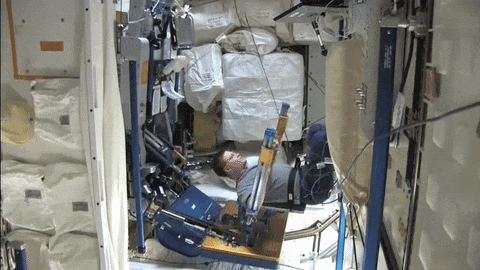
For aerobic exercise, there is the TVIS (Treadmill with Vibration Isolation and Stabilization). This treadmill uses bungee cords to hold the astronaut in place.
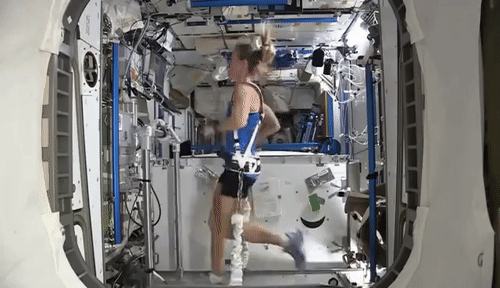
Astronauts can also use the CEVIS (Cycle Ergometer with Vibration Isolation System) for aerobic exercise. It’s similar to a stationary bike on Earth, but it’s bolted to the floor of the ISS, and astronauts must wear a seat belt to stay in place while working out.
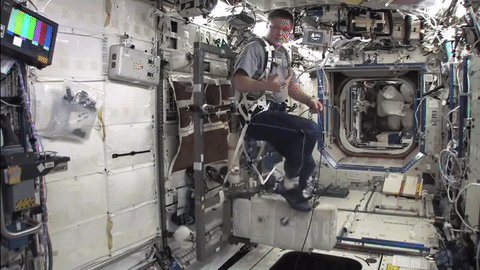
Engineers are currently designing smaller versions of these machines so that missions to Mars, which might use a vehicle smaller than the ISS, can be as efficient with their mass and volume as possible.
Is there any development on drugs/enhancements to help with the health issues associated with long term zero-gravity space travel?
At this time, we do not expect to need pharmaceuticals to manage the health issues associated with long-term zero-gravity space travel. By studying astronauts on the ISS who experience zero-gravity for long periods, we have found that regular exercise greatly mitigates harmful side-effects such as bone deterioration and muscle atrophy. We have also seen that over the average six-month stay on the ISS, bone and muscle loss levels out, but more hard data is probably needed to determine whether this will be applicable to longer missions like a 1100-day Mars mission.
Can you speak to the capabilities of Curiosity’s on-board lab?
Curiosity, which holds the Mars Science Laboratory (MSL), is the most scientifically advanced rover we’ve landed on Mars to date. Over the last eight years, Curiosity has characterized the mineralogy, geology, and chemistry of the Martian surface in Gale Crater. Examples of some of the things it can do include identifying the chemical composition of rocks and soil, searching for organic compounds, and reporting on the meteorological conditions around the rover. You can read more detail about the MSL here. Perseverance (our rover launching this summer) will build upon Curiosity’s achievements by taking one step further and collecting rock and soil samples for planned return to Earth as part of the Mars Sample Return Campaign.

Can you comment on how MEDLI2 will help these future missions?
The Mars Science Laboratory Energy Descent and Landing Instrument (MEDLI) is the set of sensors currently on Curiosity. This interview with Michelle Munk, the subsystem lead for MEDLI, goes into more detail. MEDLI2 is a second set of sensors on Perseverance. When Perseverance lands on Mars, MEDLI2 will collect data about its descent and the Martian atmosphere, which will give us information about how to best land a human crew on Mars, such as how to deal with the extreme heat generated during landing.
What will happen to the ISS after it reaches its end of lifetime?
The International Space Station’s estimated operational lifetime extends through 2028. At that point, all the countries involved, including the US, will need to decide whether certain modules should be retired or replaced (not all modules on the ISS have the same end date, since they were not all launched at the same time). Options for the ISS include letting it deorbit, replacing old modules, allowing private companies to take over its operation, or letting it continue as normal. This article from the Planetary Society goes into more detail about these options. We’re finding out that operating in the vacuum and zero-gravity environment of space is not as hard on machines as we expected, since the ISS modules are lasting longer and with less maintenance than originally anticipated. Overall, we are learning more about the ISS as we go: the lifetime of the ISS has been extended before, and it might be extended again.
Why are the solar panels all of different angles if the sun is in the same location?
Solar panels on Earth and on spacecraft are angled to maximize solar exposure, and we will want to do the same thing on Mars if we decide to use solar power there. Some solar panels on Earth can also rotate to follow the path of the sun throughout the day.
In general, solar arrays would all point in the same direction to maximize the impingement of sunlight on the solar panels. It’s not clear from the picture whether there’s distortion based on the angle the photo was taken at, but in general, we would expect the solar panels on the ISS to face the same direction.
